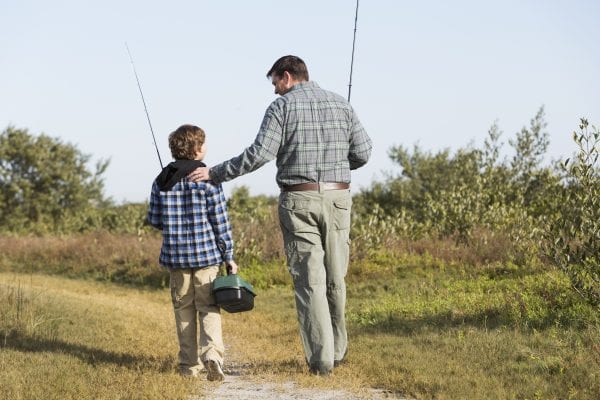Home & Family

From 1999 to 2016, Alabama experienced a 21.9 percent increase in suicides across all age groups. As the media continues to cover suicide incidents among the nation’s youth, parents are often concerned about how to discuss this topic with their children.
 While suicide is often seen as a solitary act, families, friends, and peers are often left trying to understand the reasons for the death and how to carry on with their lives. Suicide is a confusing death, especially to children and adolescents, and the lack of communication around suicide often increases the need to attach blame to someone or something. Gossip around the suicide may lead to blame, which can strain and dissolve relationships, being placed on friends, family, school, or community members. If a suicide occurs in your child’s school or community, it is important to talk to them so you can understand their feelings about a friend or classmate dying, what they know about suicide, and how they are coping with the loss.
While suicide is often seen as a solitary act, families, friends, and peers are often left trying to understand the reasons for the death and how to carry on with their lives. Suicide is a confusing death, especially to children and adolescents, and the lack of communication around suicide often increases the need to attach blame to someone or something. Gossip around the suicide may lead to blame, which can strain and dissolve relationships, being placed on friends, family, school, or community members. If a suicide occurs in your child’s school or community, it is important to talk to them so you can understand their feelings about a friend or classmate dying, what they know about suicide, and how they are coping with the loss.
Talk
When a friend, peer, or classmate dies by suicide, check in with your child to see how they are doing. Youth may not say anything and often have a range of emotions. These emotions are expressed to varying degrees, depending on their age. Discussing suicide is often difficult so having a conversation as you walk, drive, or do an activity together may make the conversation less intense.
Conversation Starters
- “I heard that X died. Are you okay? How do you feel about X’s death?”
- “What do you know about suicide? Is this something that you heard about before? Where did you hear about it?”
- “What are you hearing about this at school (or in any programs that they and the deceased child shared)?”
Important and Useful Talking Points
If rumors are being discussed in your community, address these rumors with your child.
- “There are a lot of rumors about what happened. Have you heard anything?” After leaving time for them to tell you what they have heard, let them know that the only person who really knows why this happened is X and that it is important not to feed the gossip around the death of their friend, peer, or classmate.
- “There are lots of things we do not know and the only person who really knows why this happened is X. But we do know that you can always remember all of the good times you had together.”
- “When someone dies by suicide, they choose to end their life sometimes because, in their mind, living is too hard for them. They don’t know how to get help or choose not to ask someone for help. I want you to understand that when you or others feel hurt and pain, there are people who can help. You just have to ask.”
- It is also important to ask your child if they have had thoughts about suicide—maybe after having a bad day or after an argument. If your child indicates that they have had thoughts about suicide, don’t overreact. Overreaction will close off any future communication on the topic. Not reacting or saying anything at all, however, is just a way to avoid a difficult conversation. If your child suggests that they have had thoughts of suicide (“I felt that way a while ago, but don’t anymore”), talk about what happened and why they thought about suicide. Furthermore, the conversations should ALWAYS be revisited. Remember that suicide is an attempt to solve a problem that seems impossible to solve in any other way. When you calmly ask about the problem that created the suicidal thoughts, you make it easier to bring up the subject again in the future: “I wanted to ask you again about the situation you were telling me about. How are you feeling?”
- Have a discussion about asking for help when they are having difficulties with others. Let your child know that nothing in life is ever so terrible or devastating that suicide is the way to handle it. Although children may experience a stressful interaction or feel extremely distressed, remind them that impulsively acting to hurt themselves is not the answer. Keep the door open for them to talk to you, but let them know if they feel that they cannot talk to you, they should talk to another adult, such as a trusted teacher or counselor at school; a minister, rabbi, priest, or bishop; or a trusted relative.
Be Informed about Issues Related to Children and Suicide
As a parent or guardian, it important that you have correct information about suicide. Children are exposed to information about suicide whether you talk to them or not. In a study by Dr. Brian Mishara, most of the children knew and understood the word suicide by third grade because they had talked about it with peers, seen it on TV, or overheard adults talking about it. Children who knew about killing oneself or suicide were also able to describe one or more ways of doing it. Given that most youth have heard about suicide by age 8 or 9, it’s important to bring up the topic with your children to understand what they’ve heard, read, or seen on TV. This can give you the opportunity to correct misunderstandings and to explain that suicide is a permanent answer to temporary problems.
Facts about Suicide
 Mental health conditions are often seen as the cause of suicide, but suicide is rarely caused by any single factor. In fact, many people who die by suicide are not known to have a diagnosed mental health condition at the time of death.
Mental health conditions are often seen as the cause of suicide, but suicide is rarely caused by any single factor. In fact, many people who die by suicide are not known to have a diagnosed mental health condition at the time of death.- Among youth who commit suicide, attention-deficit disorder (ADD) is more common among 5 to 11 year olds.
- Youth ages 12 through 14 are more likely to have been diagnosed with depression.
- Relationship problems are linked to suicide: 60 percent of children and 46 percent of adolescents who died from suicide had problems with friends or family members.
- School problems and recent crises are other common triggers (each present between 30 and 40 percent of cases for both children and adolescents).
- Almost all of the deaths occur at home (98 percent of children and 88 percent of adolescents).
- Children and adolescent suicides occur between the hours of noon and midnight (81 percent of children and 77 percent of young adolescents).
- By far, most children under 13 who kill themselves are boys (76 percent of those who died from 1999 through 2015 were male).
- According to national data from 2001 to 2015, suicide rates among 5 to 12 year olds were about two times higher in black children than in white children. For black children, the suicide rate increased from 1.36 to 2.54 per million, while for white children it dropped from 1.14 to 0.77 per million.
- Among 13 to 17 year olds, suicide rates are higher among white adolescents—50 percent higher in white teens than in black teens.
Although it may be difficult to talk to youth and children about suicide, it is extremely important. If you do not communicate with your child, an online search may expose them to information that is triggering and dangerous. For example, there are multiple online communities that graphically discuss suicide stories, attempts, and ways to commit suicide. Children have far more access to these stories and resources than parents may know. Therefore, monitoring your child’s online activities is important, especially because there have been incidences when apps, online forums, texts, and calls have been factors in youth committing suicide.
Suicide Services
Parents should stay informed about suicide services. Following are local and national services with helpful information.
National Suicide Prevention Hotline
- (800) 273-8225
- Online chat option available: https://suicidepreventionlifeline.org/chat/
TEEN LINE
- (310) 855-4673 or toll free at (800) 852-8336
- Or text TEEN to 839863
- Teens helping other teens talk about anxiety, depression, relationships, family issues, school, etc.
- Available 8:00 p.m. to midnight CST.
The Crisis Center–Birmingham
- General Hotline (205) 323-7777
- Teen Hotline (205) 328-6465
- Children’s Line (205) 328-5437
- Available 3:00 p.m. to 10:00 p.m. CST.
The Family Counseling Center of Mobile, Inc.
- Local Helpline (251) 431-5111
- Serves Baldwin, Clarke, Mobile, and Washington Counties.
The Crisis Center of North Alabama
- Local Helpline (256) 716-1000
- Serves Madison, Morgan, Limestone, and Jackson Counties.
The Crisis Center of East Alabama
- Local Helpline (334) 821-8600
- Serves Lee and Chambers Counties as well as West Point, Georgia.
Coping with Loss
 It is not uncommon for children to experience feelings of guilt following the loss of a friend or classmate. This is often caused by the perception that they may have somehow contributed to the death, that there was something they could have done to prevent the death, or that they failed to anticipate and intervene to prevent the suicide. It is important to let children and adolescents know that it is not their fault—nothing that they did or didn’t do caused this.
It is not uncommon for children to experience feelings of guilt following the loss of a friend or classmate. This is often caused by the perception that they may have somehow contributed to the death, that there was something they could have done to prevent the death, or that they failed to anticipate and intervene to prevent the suicide. It is important to let children and adolescents know that it is not their fault—nothing that they did or didn’t do caused this.
Guilt is a common emotion felt by youth and may particularly arise if a child had an argument or said hurtful things to or about the person before the suicide. Other effects of suicide on children include sadness, numbness, denial, mental health issues (mood disorders, anxiety disorders, suicidal behavior, post- traumatic stress disorder), emotional distress (sadness, anger), and academic and social problems (difficulty concentrating, behavioral issues at school). Children might also misbehave at home in ways not typical of their behavior before the death.
The way a child responds to a suicide is often related to how they are coping with grief. Coping with the loss does not follow a particular stage-like pattern, especially for children. Children often grieve in spurts, which may give the appearance of coping well, when suddenly an event may trigger an unexpected emotional response. Children and adolescents may or may not verbalize their grief. Sometimes they may not be able to put into words how they feel. Other times, they may get signals that talking about the suicide is wrong and creates more sadness and pain for others. Check in with children and adolescents occasionally to know how they are coping. If youth show signs of depression (lack of motivation or interest in schoolwork and activities, withdrawal (school or home), sadness, excessive guilt, hopelessness, easy irritability, or preoccupation with death/dying/self-destructive behavior, scheduling time to talk to a counselor or therapist may give them tools to help cope more effectively. Educators, researchers, and counselors agree that providing support services for grieving children is necessary to address risk factors, to decrease the risk of isolation, and to allow kids to express themselves and share with others in their own time and in their own way.
Programs in Alabama to Help Children Deal with Grief
The Amelia Center
- Birmingham
- http://www.ameliacenter.org
Eryn’s Embrace
- Montgomery
- https://www.erynsembrace.org
The Healing Place
- Muscle Shoals
- www.thehealingplaceinfo.org
Camp Good Grief
- Hospice Angels Foundation, Inc.
- Auburn
- https://hospiceangels.org/camp-good-grief
 The Harvard Child Bereavement Study found that grief does not end at a particular time for children and adolescents. Contrary to our societal beliefs that tend to say you need to move on, grief is not something youth just get over. While youth are resilient, they are not resilient enough that they will be fine because they are kids and will grow out of it. Because grief is not linear, there are key factors that can help children process their grief:
The Harvard Child Bereavement Study found that grief does not end at a particular time for children and adolescents. Contrary to our societal beliefs that tend to say you need to move on, grief is not something youth just get over. While youth are resilient, they are not resilient enough that they will be fine because they are kids and will grow out of it. Because grief is not linear, there are key factors that can help children process their grief:
- Learning to cope with emotions and other changes resulting from loss
- Developing a new type of relationship or attachment with the deceased based on remembrance
- Finding meaning from the experience of loss
- Moving forward and absorbing the experience into their lives
For many youth, researchers have concluded that some circumstances—a murky understanding of death; relationship problems; prevalence of ADHD, depression, and/or other mental health issues; and the wish for control—can lead children experiencing a stressful interaction and feeling extremely distressed but not knowing how to cope to impulsively hurt themselves, perhaps not really expecting to die.
It is a natural reaction to feel frightened or worried following the death of your child’s friend or classmate and to avoid talking about it. However, it is important to talk to your children, provide honest information, and offer support when they need it. Youth should know that their friend’s death is something they can talk about with you. They also need to know that you are available to help them if they themselves feel distressed to the point of committing suicide.
Adrienne M. Duke, Extension Specialist, Assistant Professor, Human Development and Family Studies, Auburn University
New February 2019, Helping Children and Adolescents Cope with Suicide, FCS-2304

